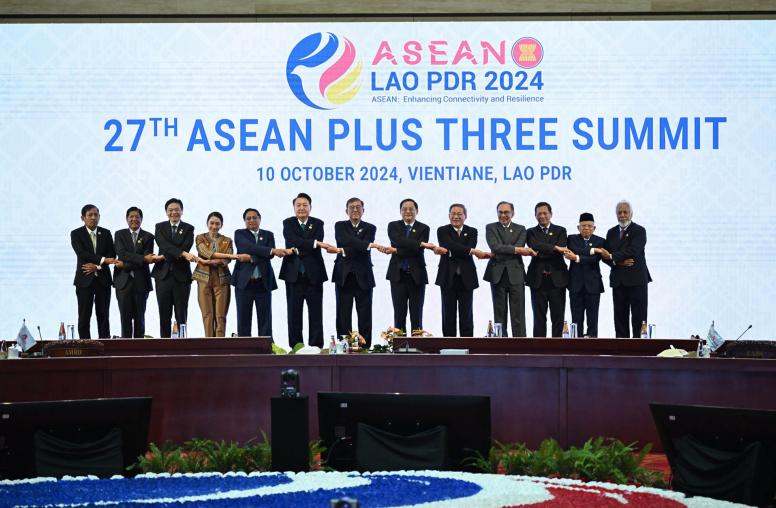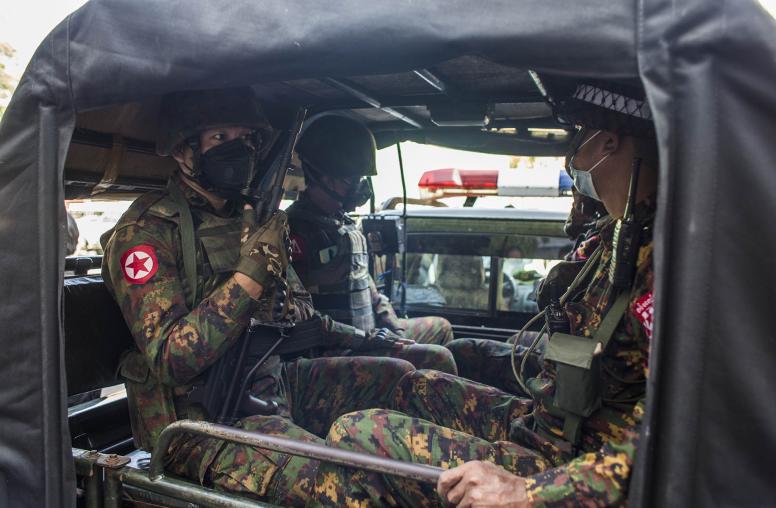How Myanmar’s Coup Opens Opportunity for National Reconciliation
To change the trajectory of the conflict, the opposition must unify around a much-needed nation-building process.
Since Myanmar’s military illegally deposed the country’s elected government on February 1, it has killed more than 1,000 people and is actively undermining efforts to manage the COVID pandemic by arresting volunteer doctors, blocking imports of medical supplies and hoarding and stealing oxygen. The military’s inhumanity and daily atrocities have created a common enemy for a divided society and a rare opportunity for the Myanmar people to initiate a much-needed nation-building process. The opposition is a loose group of organizations largely held together by a shared hatred for the military. If it is to decisively shift the trajectory of this conflict and end the military’s 70-year stranglehold on power, it will need to unify through a transformative reconciliation process.

A History of Division
For nearly 70 years, Myanmar, a nation of more than 100 distinct ethnic groups haphazardly glued together by the British, was ruled by an ethno-nationalist Bamar regime. It was built on a colonial system of racial hierarchy that divided communities into “national races” and religions. Successive military regimes have maintained power through violence and division, intentionally inciting inter-ethnic and inter-religious conflict to ensure it would never face a unified opposition.
The country was founded on an agreement that assured equality, self-determination and the right to secede to all ethnic nationalities — but it was never honored. This original betrayal ignited a civil war between the Bamar majority and ethnic minority insurgent armies that continues today. Ethnic minority populations have, for decades, been subjected to a perpetual state of occupation characterized by sexual violence, cultural suppression and economic exploitation — typically at the hands of the Bamar majority, but in some cases by large ethnic minorities against smaller groups. Decades of division have fostered deep mistrust between and among ethnic minority and Bamar communities, including those who stand shoulder-to-shoulder in defiance of the military today.
It was hoped that the National League for Democracy’s (NLD) landslide victory in the 2015 elections would create an opening for national reconciliation and inclusive democratic consolidation. Instead, the Bamar-dominated NLD government maintained structures of discrimination and prioritized compromise and reconciliation with the military — even defending the Rohingya genocide at the Hague. “If we cannot reconcile with old enemies [the military], how are we to go forward as a nation,” said Aung San Suu Kyi. This was a tragic miscalculation.
An Opening for Reconciliation?
Amid the atrocities and chaos that followed the coup, there is a new opportunity for national reconciliation. The National Unity Government (NUG) and the Committee Representing the Pyidaungsu Hluttaw (Myanmar’s legislature), primarily made up of the younger generation of the deposed NLD government, is desperately scrambling to develop a unified multi-ethnic political and armed coalition to confront the military junta. Ethnic armed organizations (EAOs) and ethnic communities are assessing the options of either joining forces with the NUG or pursuing greater autonomy, which may be more likely now than ever given their position of political strength. Six months after the coup, the opposition movement remains fractured.
However, reconciliation is a top priority for the NUG. In a recent conversation with USIP, Zin Mar Aung, the NUG’s foreign affairs minister, stressed the importance of national reconciliation: "As Myanmar is home to multi-ethnic groups, federalism is the only solution. This revolution is not only meant to uproot dictatorship from our land. We have a vision for state-building … to end decades long inequality and discrimination. In this regard, reconciliation and unity among different ethnic groups is utmost important and it is the key to end [the military junta].”
There are at least three tracks of reconciliation that will need to take place. The first is between the military and the NUG-led civilian government. The second is between the NUG and civil society, which opposed the military and the NLD when it was in power. The third is between the minority ethnic groups and the Bamar majority.
For any of these processes to be successful, there will also need to be intra-group processes, due to the divisions and fragmentation pervasive throughout Myanmar society. “This will require the NUG and NLD leadership to come to terms with the latter’s systematic exclusion of youth and women; that EAOs consider how their own narratives sustain systems of exclusion; and that civil society addresses the sharp divisions that have emerged between elite and grassroots organizations,” said USIP Myanmar Country Director Jason Tower.
The first of these three processes seems highly unlikely to occur anytime soon with both sides publicly opposed to dialogue. The latter two tracks, though, can begin now and would have major implications for the first. A unified civilian population and government would constitute a formidable force that could transform the entrenched system of elite military domination.
A unified movement could decisively alter the military’s calculations. But in the absence of such unity, the NUG may slowly lose legitimacy with local populations, attenuating its primary source of power, and the country could fall into a deeper state of sustained conflict. To unify, the opposition must undertake a transformative reconciliation process built upon principles of restorative justice. Such a process must include three elements: acknowledging the past, establishing new norms and relationships, and constructing a shared vision for a just, inclusive society.
1) Acknowledging the Past
This means going backwards to go forwards by jointly facing the past and participating in a process of truth-telling. Achieving restorative justice requires answering three critical questions: Who has been harmed? What needs have arisen? And whose responsibility or obligation is it to redress these harms? By answering these questions through inclusive processes that center the voices of victim-survivors and hold offenders accountable, healing and justice can be achieved. This process of truth-telling would take many decades and should include involvement from institutions like the International Criminal Court, but it can begin now.
The NUG has made important progress by publicly acknowledging harms committed against the Rohingya; however, a broader effort that examines the dark history of violence against and alienation of ethnic and religious minorities is critical for reconciliation to occur between the NUG, civil society and the many ethnic groups that have been underrepresented for too long.
2) Setting New Norms and Relationships
This involves going down to go up by digging out the roots of conflict and distrust before constructing new norms. Myanmar has suffered the indignities of what John Paul Lederach, a professor of peacebuilding at Notre Dame University, calls “enemy formation” for far too long now — much of which has been perpetuated through military-constructed narratives that have poisoned the education system and pervaded cultural norms. For reconciliation to occur, the country must embark on an intentional process of individual and collective healing and a joint pursuit of a just political order.
The NUG has made some progress here by abolishing the discriminatory 2008 constitution, scrapping the racist citizenship law and facilitating ethnic minority involvement in drafting of the Federal Democracy Charter, which articulates a vision for governance structures. But the NUG has also continued many of the NLD’s exclusionary practices. In the absence of formal democratic structures, the NUG must create them. “Inclusion is about more than simply appointing people with diverse backgrounds … it is about making decisions together through a consultative and deliberative process,” said a policy analyst from the Shan minority interviewed for this article.
With the support of external facilitators, a dialogue process between the NUG, civil society and representatives of all ethnic groups should be designed and facilitated; the National Unity Consultative Council (NUCC) could be an important actor in this process if it’s empowered to do so. This dialogue would build off or be integrated with efforts to acknowledge past harms. It would aim to define a working relationship between all parties and would build toward consensus on a collaborative relationship between the civilian government and civil society. A parallel intra-civil society reconciliation effort will be critical as well, given deep divisions along lines of identity, location and resources.
3) Constructing a Vision of a Just and Inclusive Society
This requires collaboratively constructing a shared vision in which all members of society can see themselves thriving. In a democracy, there will always be disagreements on specific outcomes and how to achieve them, but the NUG has an opportunity to articulate an overarching vision for Myanmar’s future. Hope for a better future is crucially needed to sustain the opposition during this moment of deep despair. The Federal Democracy Charter, announced on March 31, is one method of articulating this vision. The drafting of the charter represents a significant step, not only because of its content, but because it was developed by the NUCC, which includes representatives from different ethnic groups including EAOs. Critically important, it outlines future government structures, although this part was drafted with less consultation from ethnic minorities and reinforced suspicions over the NUG’s political will for power-sharing.
To build trust in the NUG’s intention and ability to achieve its vision, the NUG must also deliver tangible results for the tens of millions who cast votes for the NLD in 2020. Success in confronting the junta depends not on gaining formal recognition from foreign nations — which has at times seemed to be the NUG’s focus — but on building domestic legitimacy and trust. The former will follow the latter. If the NUG can provide services in an equitable and inclusive way, it will be a vital step toward a more just and inclusive society. Meeting the urgent challenges of COVID-19, food insecurity, safety and education will be a critical starting point.
These three steps toward reconciliation are also essential elements of the movement-making process. In the near term, they are critical to building a durable and inclusive civilian coalition large enough to confront the military. In the long term, they are steps toward inclusive nation-building. Elite-driven processes, like those proposed by many in the international community, that exclude communities and ignore past harms, predictably result in the recurrence of violence.
Each time the military has faced mass resistance it has retained power because the opposition has failed to unify. Today’s movement has shown signs that it is willing and able to address its internal divisions and unify around a vision for a more inclusive, equitable Myanmar. If the NUG builds off these efforts and leads the nation in a reconciliation process, the opposition could unify to defeat the military, build resilience to future military coups and set the country on a path toward sustainable peace.
Hkawn Htoi is a technical specialist for research and dialogue initiatives for the Institute in Myanmar. Carl Stauffer is a senior expert on reconciliation for the Institute.



